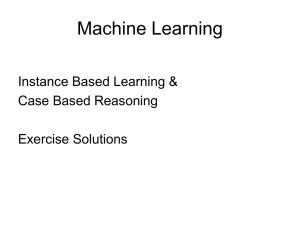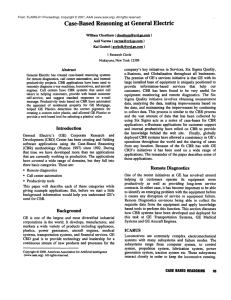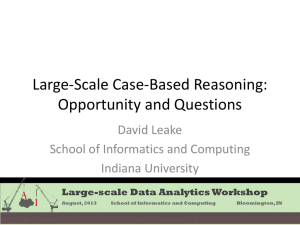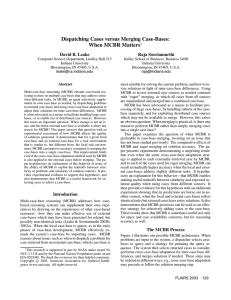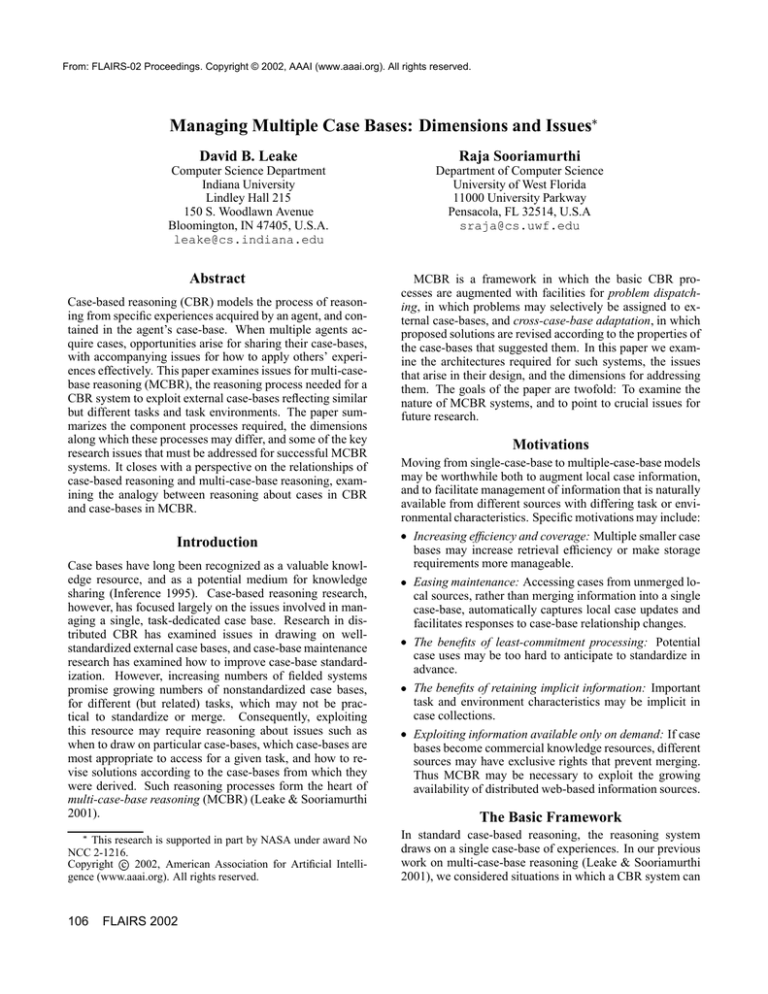
From: FLAIRS-02 Proceedings. Copyright © 2002, AAAI (www.aaai.org). All rights reserved.
Managing Multiple Case Bases: Dimensions and Issues
David B. Leake
Raja Sooriamurthi
Computer Science Department
Indiana University
Lindley Hall 215
150 S. Woodlawn Avenue
Bloomington, IN 47405, U.S.A.
leake@cs.indiana.edu
Department of Computer Science
University of West Florida
11000 University Parkway
Pensacola, FL 32514, U.S.A
sraja@cs.uwf.edu
Abstract
Case-based reasoning (CBR) models the process of reasoning from specific experiences acquired by an agent, and contained in the agent’s case-base. When multiple agents acquire cases, opportunities arise for sharing their case-bases,
with accompanying issues for how to apply others’ experiences effectively. This paper examines issues for multi-casebase reasoning (MCBR), the reasoning process needed for a
CBR system to exploit external case-bases reflecting similar
but different tasks and task environments. The paper summarizes the component processes required, the dimensions
along which these processes may differ, and some of the key
research issues that must be addressed for successful MCBR
systems. It closes with a perspective on the relationships of
case-based reasoning and multi-case-base reasoning, examining the analogy between reasoning about cases in CBR
and case-bases in MCBR.
MCBR is a framework in which the basic CBR processes are augmented with facilities for problem dispatching, in which problems may selectively be assigned to external case-bases, and cross-case-base adaptation, in which
proposed solutions are revised according to the properties of
the case-bases that suggested them. In this paper we examine the architectures required for such systems, the issues
that arise in their design, and the dimensions for addressing
them. The goals of the paper are twofold: To examine the
nature of MCBR systems, and to point to crucial issues for
future research.
Motivations
Moving from single-case-base to multiple-case-base models
may be worthwhile both to augment local case information,
and to facilitate management of information that is naturally
available from different sources with differing task or environmental characteristics. Specific motivations may include:
Increasing efficiency and coverage: Multiple smaller case
bases may increase retrieval efficiency or make storage
requirements more manageable.
Easing maintenance: Accessing cases from unmerged local sources, rather than merging information into a single
case-base, automatically captures local case updates and
facilitates responses to case-base relationship changes.
The benefits of least-commitment processing: Potential
case uses may be too hard to anticipate to standardize in
advance.
The benefits of retaining implicit information: Important
task and environment characteristics may be implicit in
case collections.
Exploiting information available only on demand: If case
bases become commercial knowledge resources, different
sources may have exclusive rights that prevent merging.
Thus MCBR may be necessary to exploit the growing
availability of distributed web-based information sources.
Introduction
Case bases have long been recognized as a valuable knowledge resource, and as a potential medium for knowledge
sharing (Inference 1995). Case-based reasoning research,
however, has focused largely on the issues involved in managing a single, task-dedicated case base. Research in distributed CBR has examined issues in drawing on wellstandardized external case bases, and case-base maintenance
research has examined how to improve case-base standardization. However, increasing numbers of fielded systems
promise growing numbers of nonstandardized case bases,
for different (but related) tasks, which may not be practical to standardize or merge. Consequently, exploiting
this resource may require reasoning about issues such as
when to draw on particular case-bases, which case-bases are
most appropriate to access for a given task, and how to revise solutions according to the case-bases from which they
were derived. Such reasoning processes form the heart of
multi-case-base reasoning (MCBR) (Leake & Sooriamurthi
2001).
This research is supported in part by NASA under award No
NCC 2-1216.
Copyright c 2002, American Association for Artificial Intelligence (www.aaai.org). All rights reserved.
106
FLAIRS 2002
The Basic Framework
In standard case-based reasoning, the reasoning system
draws on a single case-base of experiences. In our previous
work on multi-case-base reasoning (Leake & Sooriamurthi
2001), we considered situations in which a CBR system can
augment its local case-base by drawing on a single external
case-base when needed. However, in general an MCBR system could have many case-bases to choose from. For example, a system to predict product prices might draw on the catalogs of multiple stores; an on-line travel guide could draw
on repositories of traveler comments published by many different groups, etc. Because those case-bases may have differing coverage characteristics, a multi-case-base reasoner
may need to reason about the case-base from which to draw
cases. Likewise, because different case-bases may reflect
different problem circumstances, a multi-case-base reasoner
may need to adapt cases based on their sources in addition to
responding to differences in the stated problem descriptions.
Thus any MCBR system requires components to perform
four basic functions:
Standard CBR
Problem
4. Cross-case-base adaptation: When case-bases deal with
differing tasks or task environments, the solutions that
they suggest may need additional adjustment in response
to those differences (e.g., a case-base of products might
return prices in dollars when the desired prices are in euros). The cross-case-base adaptation component adjusts
solutions for these inter-case-base differences.
Architectures for MCBR
One possible MCBR architecture is the simple “fallback”
architecture, shown in Figure 1. In this architecture, a CBR
system draws on external cases when it determines that its
own case library is insufficient. Here dispatching could be
based on the level of similarity between current problem and
most similar local case; case selection based on whether the
external case actually addresses a more similar problem, and
cross-case-base adaptation based on sampling the external
case-base to estimate inter-case-base solution differences.
More generally, an MCBR system may draw on any number of case-bases, accessed according to strategic criteria.
Figure 2 shows one such architecture. When a problem is
input to the MCBR system, a dispatcher determines case
bases to query and a strategy for how to pursue the query
Revise
Solution
Remote
Case
Base
Local
Case
Base
Cross Case−Base
Adaptation
Figure 1: Drawing on an external case-base when the local
case-base is insufficient.
3. Solution merging: The solution merging component determines how the solutions from the set of selected cases
will be combined into the final solution. For example,
for a numerical prediction task, numerical values might
be averaged; for a planning task, portions of the retrieved
plans might be merged according to preference criteria.
Adapt
Case Dispatch
1. Problem dispatching: The dispatching component determines the set of case-bases to which a problem is sent.
This may be based on criteria such as estimated likelihood
that the case-base will contain a relevant case, expected
speed of response, or cost of requesting information from
a commercial case source.
2. Case selection: The selection component determines
which cases to consider as candidates for contributing to
the solution. For example, selection might return the first
case retrieved; might wait for all queried case-bases to respond and return the most similar case, or all cases within
a set similarity threshold; or might return cases from all
case-bases that respond within a given time limit.
Retrieve
Case-base characterization
Problem dispatching
Case selection
Solution merging
Cross-case-base adaptation
Multi-case-base maintenance
Table 1: Issues for MCBR design.
sequence. The system then selects results to consider, performs cross-case-base adaptation to adjust for inter-casebase differences, and merges solutions if multiple solutions
will be used. (Depending on the system strategy, these steps
may be ordered in different ways.) The result is then passed
on to a standard CBR process.
We note that this general architecture includes the previous architecture as a special case. A “local” case-base need
not be distinguished from other case-bases, except as encoded by the dispatching strategy. For example, a local casebase would presumably have very low access cost, causing
it to be favored by a cost-based dispatching strategy, and
would require only the identity function for cross-case-based
adaptation, causing it to be favored by a dispatching strategy
favoring cases for similar problems.
Issues for Multi-Case-Base Reasoning
Applying the MCBR architecture requires addressing both
the standard CBR issues—for processing of the cases that
are retrieved—and addressing the new issues that arise from
multiple case bases, as summarized in Table 1. The following sections summarize each of these issues and highlight
the dimensions of how they may be addressed.
Case-Base Characterization
Just as case indexing plays a crucial role in CBR, casebase characterization is vital to MCBR. As for case indexing, case-base characterization must provide the information
needed to estimate the usefulness of the case-base. Because
FLAIRS 2002
107
Case
Base
Solution
Selector
Standard CBR
Problem
Case
Dispatcher
Cross
CaseBase
Adapter
Case
Base
...
Adapt
Solution
Revise
Solution
Merger
Case
Base
Figure 2: Multi-case-base reasoning framework for drawing on a set of case-bases.
the question is the relevance of the case-base, rather than
of a case, the information must be predictive of the likelihood of the case-base to contain cases addressing a particular problem. This includes coverage information expressing
the likelihood of the case-base containing cases for the problem at hand. At a coarse-grained level, the characterization
might include global competence information; at a finergrained level, it might include descriptions of more specific
expertise. Likewise, it includes task information, to compare
to the task at hand to estimate the difficulty of cross-casebase adaptation. In addition, because different case-bases
have different access characteristics (in terms of how to formulate queries, availability, expected response time, etc.), it
must include access characteristics.
Problem Dispatching
Dispatching policies use case-base characterizations to determine which case-base(s) should be used to solve a particular problem. For purposes of dispatching, no distinction is
made between the local case-base and external case-bases:
Choices of when to use the local case-base are made according to the same types of reasoning processes used to
decide when to access an external case-base. In this way, the
dispatching policies simultaneously address the questions of
“when to dispatch” and “where to dispatch.”
The dispatcher’s decision-making may depend on arbitrarily sophisticated reasoning. It may be based on any aspects of the problem to solve (e.g., using the characterization
to decide which case-base is most relevant), on the overarching system task and constraints (e.g., needs for rapid response), and on information about external constraints and
circumstances (e.g., that an overburdened external case-base
should be accessed only when necessary). The dispatching
process may be targeted at retrieving a single case, or a set
of cases; multiple retrievals are resolved during the selection/merging phase.
Dispatching policies fall into four possible categories:
One-shot dispatching: Closest to traditional CBR, dispatching may simply choose to dispatch a problem to one
or more of the external case-bases, for the results to be
processed directly by the case selection/merging phase.
108
FLAIRS 2002
Sequential dispatching: Sequential dispatching prioritizes dispatching targets and determines a sequence of
queries, based on the sequence of results, to implement
an information-seeking strategy. For example, a simple
two-step policy might solve problems locally if the local
case-base has a sufficiently similar case, and otherwise
send the problem to a remote case-base.
Parallel dispatching: Parallel dispatching broadcasts requests simultaneously to a set of case-bases.
Hybrid dispatching: Hybrid dispatching methods involve
a sequence of dispatches, combining parallel and sequential dispatching steps.
If an MCBR system is drawing on the case-bases of other
MCBR systems, we may imagine a federation of communicating systems. In such systems, another dimension is dispatcher integration—the level of centralization or information sharing between individual MCBR systems. For example, to illustrate two extremes, multiple systems might
be designed to communicate with a central registry of available case-bases and their characteristics, or each maintaining
their own dispatching information.
Another issue, arising from the perspective of the casebases being queried, is query acceptance. With sufficient
reasoning capability and rich-enough queries, a case-base
might assess its own willingness to process a query and
competence in the query area, possibly to itself dispatch the
problem to another source.
Case Selection and Solution Merging
Because an MCBR system may send simultaneous queries
to multiple case-bases, policies are needed for how to select
the returned cases to consider and to merge their suggested
solutions. A first-pass selection policy might simply use the
first case that is returned; a somewhat more subtle approach
might accumulate cases with a cut-off policy (e.g., ignoring
future returned cases when a certain number of cases has
been retrieved, or when a case of sufficient quality has been
retrieved). The availability of multiple cases also presents
opportunities for applying ensemble methods to multiple solutions.
The selection/merging process becomes more subtle
when the application of a prior case begins before retrievals
are complete. In that situation, later retrievals may provide
useful information to shape or even replace the current reasoning process. This merging requires reasoning not only
about the usefulness of a case, but how much it contributes
beyond the current system state. For example, even if much
effort has been expended on a candidate solution, it may be
appropriate to discard that work if a complete prior solution
has been found.
Cross-Case-Base Adaptation
In order for an MCBR system effectively use case-bases that
may have been developed in different ways, for different
tasks or task environments, methods are needed to adjust retrieved cases for local needs. The cross-case-base adaptation
process adapts suggested solutions from one case base to apply to the needs of another. It corresponds to the case adaptation process for a CBR system, but with the difference that
its role is to adapt in response to the differences in sources of
cases, rather than differences between the current and prior
problems. Those problem-based differences are accounted
for by the standard CBR process, after cross-case-base adaptation has produced a case compatible with the local CBR
system. Each pairing of a CBR system with a destination
case-base may require different adaptation strategies.
Cross-case-base adaptation may need to address syntactic or semantic representational differences, as well as differences in tasks and task environments that simply affect
attribute values. In order to select appropriate cross-casebase adaptation strategies, a system must have (or be able
to derive) information about the relationships between solutions in its own case-base and the external case-base. To
enable this, a fundamental issue is how to derive the needed
metadata. We are currently exploring sampling methods for
comparing case-base characteristics in order to select appropriate cross-case-base adaptation strategies.
Multi-Case-Base Maintenance
Traditional case-base maintenance focuses on issues of individual case bases, such as how to standardize case-base contents or compact the case-base. MCBR must address these
issues for individual case-bases, as well as additional issues
that arise in the MCBR context:
Standardization: Case-base standardization can function
as an “eager” analogue to cross-case-base adaptation: It
can adjust for systematic differences that otherwise would
need to be addressed as cases are applied.
Split and reform: MCBR maintenance adds the choice of
how many case-bases to use and their makeup. Splitting
a large case-base into smaller, task-focussed case-bases
may enable more efficient retrievals; Merging two casebases may yield increased breadth, as coverage increases,
or depth, as multiple case-bases become available for the
same part of the case-base.
Analogies to CBR: The Continuum from
Reasoning about Cases to Reasoning about
Case-Bases
The previous sections highlight the operations that MCBR
systems require, beyond those required for standard CBR.
Operations such as case-base indexing, and cross-case-base
adaptation, may be viewed as simply the standard CBR processes, applied to a case-base of case-bases. Given this correspondence, we may view a CBR system as an MCBR
system, in which each of the MCBR system’s case-bases
contains a single case, and the MCBR system’s dispatching process corresponds to normal case retrieval. Likewise,
any MCBR system can be transformed into a standard CBR
system by merging its cases. Thus we can view CBR and
MCBR as falling on a continuum. At one extreme, there is
a single, unified case-base; at the other, there is a different
case-base for every domain case. Processing of both endpoints in the continuum is isomorphic, with case indexing
in CBR corresponding to case-base indexing for the singleton case-bases. The MCBR split and reform maintenance
operations provide a way to move along this continuum.
The principles of MCBR can also apply to multiple retrievals from a single case-base. For example, (Riesbeck
1996) proposed a CBR model in which processing begins
based on an initial retrieval, with retrieval processes continuing in case more appropriate case-bases are available. This
model corresponds to MCBR with multiple retrievals from
the same case-base, and utility-based case solution merging.
In terms of maintenance, MCBR’s cross-case-base adaptation can be seen as a form of “lazy” case standardization: Cases are converted to the form of the local system
as needed. (Leake & Wilson 1999) discusses an analog to
MCBR’s splitting operation, applied to standard CBR: Identifying “hot spots” in the problem space, based on current
problems, to selectively place cases less likely to be used in
a secondary case-base if storage capacity is limited or utility
problems interfere with retrieval efficiency.
Related Research
Methods for managing sharing of standardized case-bases
have been studied in research on distributed CBR (e.g.,
(Martin, Plaza, & Arcos 1999)), as have methods for facilitating large-scale case distribution (Hayes, Cunningham,
& Doyle 1998). However, these methods do not address
the cross-case-base adaptation needed for non-standardized
cases. Relevant to dispatching issues, (McGinty & Smyth
2001) highlight the value of case-base specific expertise in
drawing on external case-bases, and describe a system that
dispatches cases to provide personalized recommendations.
The use of multiple case-bases in MCBR has a number of
analogs in the database community, in research areas such as
component database systems (Dittrich & Geppert 2001), and
in studies of management issues for heterogeneous database
systems (Elmagarmid, Rusinkiewicz, & Sheth 1999). How
to address structural and syntactic differences between heterogeneous database systems has been investigated extensively in research on interoperability and scheme integration. This work, and AI research in areas such as learning
FLAIRS 2002
109
to translate between ontologies and data integration (e.g.,
(Domingos 2000)), are likely to prove highly relevant to
cross-case-base adaptation issues.
Conclusion
Multi-case-base reasoning augments CBR with capabilities
for reasoning about which case bases to use, and how to use
them. Its selective, lazy access of nonstandardized cases can
provide a useful supplement to a local case base, and the
framework it requires provides a uniform way to access distributed case resources. The MCBR framework can also be
applied to combine a number of CBR systems, each generating and drawing on shared case resources.
At a high level, many of the processes needed for MCBR
parallel those of the normal CBR process, showing the applicability of lessons from CBR, but many specific multicase-base issues arise as well. These point to new research
areas and new opportunities for intelligent sharing and reuse
of case knowledge from multiple sources.
References
Dittrich, K., and Geppert, A. 2001. Component Database
Systems. Morgan Kaufmann.
Domingos, P. 2000. Data integration: A “killer app” for
multi-strategy learning. In Proceedings of the Fifth International Workshop on Multistrategy Learning. Menlo Park,
CA: AAAI Press.
Elmagarmid, A.; Rusinkiewicz, M.; and Sheth, A. 1999.
Management of Hetergenous and Autonomous Database
Systems. Morgan Kaufmann.
Hayes, C.; Cunningham, P.; and Doyle, M. 1998. Distributed CBR using XML. In Proceedings of the KI98 Workshop on Intelligent Systems and Electronic Commerce.
Inference. 1995. Inference forms knowledge publishing
division. Press release, Inference Corporation, November
17, 1995.
Leake, D., and Sooriamurthi, R. 2001. When two
case bases are better than one: Exploiting multiple case
bases. In Case-Based Reasoning Research and Development: Proceedings of the Fourth International Conference
on Case-Based Reasoning, ICCBR-01. Berlin: SpringerVerlag.
Leake, D., and Wilson, D. 1999. When experience is
wrong: Examining CBR for changing tasks and environments. In Proceedings of the Third International Conference on Case-Based Reasoning, 218–232. Berlin: Springer
Verlag.
Martin, F.; Plaza, E.; and Arcos, J.-L. 1999. Knowledge and experience reuse through communications among
competent (peer) agents. International Journal of Software
Engineering and Knowledge Engineering 9(3):319–341.
McGinty, L., and Smyth, B. 2001. Collaborative casebased reasoning: Applications in personalised route planning. In Case-Based Reasoning Research and Development: Proceedings of the Fourth International Conference
on Case-Based Reasoning. Berlin: Springer Verlag.
110
FLAIRS 2002
Riesbeck, C. 1996. What next? The future of CBR in
postmodern AI. In Leake, D., ed., Case-Based Reasoning:
Experiences, Lessons, and Future Directions. Menlo Park,
CA: AAAI Press. 371–388.

